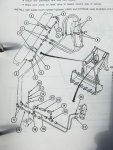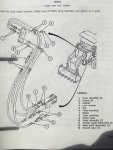People can with a little practice, dig the bucket into the ground at just the right angle, then drive forward slowly in low which will raise the front wheels..but I concur it would be nice to lift the truck with that bucket with hydraulics alone, which in practice works on most front bucket backhoes, but not with my SEE. I too took a look at doing this, even altering the geometry of the front tilt lifter bars, which seem quite delicate and a little flimsy. Next to the hydraulics, they appear to be the weak link in this system from a backyard engineering perspective, with no lateral stability from them once you did manage to lift the truck. My experience with german engineering concludes this limitation was intentional and I can only imagine the discussion as to every possible situation where lifting the truck with both implements could cause a disaster leading to a determination that the bucket should not be able to accomplish this task. After getting completely stuck in soft clay mud and burying both axles, I can tell you it was frustrating not to be able to use both implements to crawl out, and with the front wheels in holes, the rear alone was not able to lift and pull me out. Getting unstuck took tying a 60hp tractor in neutral with all the chain I had on hand to the backhoe, and then a F350 with a 20000lb winch all the way out to the front of the tractor. Between 4WD low reverse, the winch, and the backhoe assisting as a lever, we were free again. Another modification I am considering is an attachment for the rear bucket that once quickly clamped on can be driven down into the earth a few feet( something with 3+ rebar fingers that levers onto the backhoe bucket maybe) to then allow the strength of the backhoe to lift and pull me backwards out of a predicament without simply taking a bucket full of soup and moving it in the wrong direction!
The questions are;
1. do we want to lift just over half the weight of the truck with the bucket, barely getting the front wheels off the ground, or once the backhoe has lifted the rear, will we be moving the full weight with the bucket in order to completely raise the entire vehicle? If lifting the front first will there be enough holding power to keep it airborne when lifting from the rear second?
2. Do we want to lift the weight of the whole truck with just the tilt lever, just the up lever, with either lever, or with a magic combination of them both simultaneously?
3. Do we want more pressure? Faster flow rates, or both?
4. Is the most economical option plumbing the rear pump to the front for one or both operations? Is there a way to do this with a separate lever/shutoff combination for just this purpose, leaving the original setup in place?
5. Will I have to wear an improved "safety shirt" once this is accomplished?




